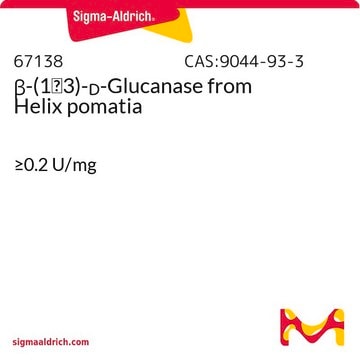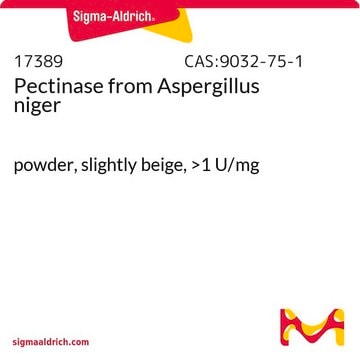C8274
Cytohelicase from Helix pomatia
lyophilized powder
Synonyme(s) :
Snail gut enzyme
Se connecterpour consulter vos tarifs contractuels et ceux de votre entreprise/organisme
About This Item
Numéro CAS:
Numéro CE :
Numéro MDL:
Code UNSPSC :
12352204
Nomenclature NACRES :
NA.54
Produits recommandés
Forme
lyophilized powder
Composition
Protein, 50-80% Lowry
Température de stockage
2-8°C
Application
Cytohelicase from Helix pomatia has been used:
- in the enzyme solution for preparing the cell nuclei for immuno fluorescent in situ hybridization (immunoFISH)
- in the enzyme mix to analyze meiotic cells at diakinesis and later stages in anthers
- in the enzyme mix for the analysis of mitosis in anthers
Cytohelicase from Helix pomatia has been used to study the isolation of yeast protoplasts using various preparations of the hepato-pancreatic juice of Helix pomatia.
The enzyme from Sigma has been used for cytohelicase assay. The enzyme assay was used while studying the effects of MNN10 gene-disruption on protein secretion in Kluyveromyces lactis and Saccharomyces cerevisiae cultures.
Actions biochimiques/physiologiques
Cytohelicase from Helix pomatia is used in the preparation of synaptonemal complex spreading techniques along with bovine serum albumin. It plays an important role in the digestion of cell wall. Cytohelicase interacts with chromatin and improves the adhesion of synaptonemal complexes to the hydrophobic plastic film.
Remarque sur l'analyse
Contains glucanase/laminarinase activity
Mention d'avertissement
Danger
Mentions de danger
Conseils de prudence
Classification des risques
Resp. Sens. 1
Code de la classe de stockage
11 - Combustible Solids
Classe de danger pour l'eau (WGK)
WGK 1
Point d'éclair (°F)
Not applicable
Point d'éclair (°C)
Not applicable
Équipement de protection individuelle
Eyeshields, Gloves, type N95 (US)
Certificats d'analyse (COA)
Recherchez un Certificats d'analyse (COA) en saisissant le numéro de lot du produit. Les numéros de lot figurent sur l'étiquette du produit après les mots "Lot" ou "Batch".
Déjà en possession de ce produit ?
Retrouvez la documentation relative aux produits que vous avez récemment achetés dans la Bibliothèque de documents.
Les clients ont également consulté
Sònia Garcia et al.
BMC plant biology, 12, 95-95 (2012-06-22)
In plants, the 5 S rRNA genes usually occur as separate tandems (S-type arrangement) or, less commonly, linked to 35 S rDNA units (L-type). The activity of linked genes remains unknown so far. We studied the homogeneity and expression of
Simon Amiard et al.
PloS one, 9(1), e86220-e86220 (2014-01-28)
In striking contrast to animals, plants are able to develop and reproduce in the presence of significant levels of genome damage. This is seen clearly in both the viability of plants carrying knockouts for key recombination and DNA repair genes
Danguole Bartkeviciūte et al.
FEMS yeast research, 4(8), 833-840 (2004-09-29)
Screening for genes affecting super-secreting phenotype of the over-secreting mutant of Kluyveromyces lactis resulted in isolation of the gene named KlMNN10, sharing high homology with Saccharomyces cerevisiae MNN10. The disruption of the KlMNN10 in Kluyveromyces lactis, as well as of
Mikhail G Divashuk et al.
PloS one, 9(1), e85118-e85118 (2014-01-28)
Hemp (Cannabis sativa L.) was karyotyped using by DAPI/C-banding staining to provide chromosome measurements, and by fluorescence in situ hybridization with probes for 45 rDNA (pTa71), 5S rDNA (pCT4.2), a subtelomeric repeat (CS-1) and the Arabidopsis telomere probes. The karyotype
Ribosomal DNA locus evolution in Nemesia: transposition rather than structural rearrangement as the key mechanism?
Datson PM and Murray BG
Chromosome Research, 14(8), 845-857 (2006)
Notre équipe de scientifiques dispose d'une expérience dans tous les secteurs de la recherche, notamment en sciences de la vie, science des matériaux, synthèse chimique, chromatographie, analyse et dans de nombreux autres domaines..
Contacter notre Service technique















